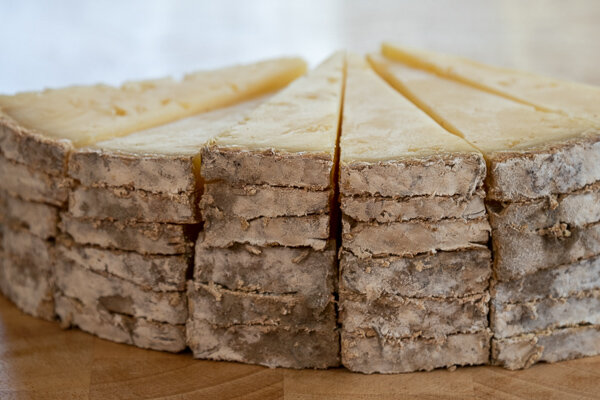Who knows whether Charles de Gaulle really said, “How can you govern a country that makes 246 cheeses?” If he did, he was underestimating. I think I’ve had 246 French cheeses myself, and I’m still discovering new ones. Take a look at the seven beauties I served last week in my “France Off the Beaten Path” tasting and see how many you know. Two were new to me. And I have to say, the class favorite surprised me.
Starting from the 12 o’clock position, meet Rondelaine, a bloomy-rind sheep cheese from acclaimed affineur Pascal Beillevaire. This five-ounce youngster comes from the Poitou-Charentes, in western France, and hops a plane to the U.S. when it’s only two to three weeks old. It had a lovely sour-cream and mushroom aroma, a soft and wrinkly Geotrichum rind and a dense yet creamy texture.
Moving clockwise, we have Roue Ardoisée (“slate-colored wheel”) an ashed doughnut-shaped goat cheese. Beillevaire is the affineur, but I’m almost certain the producer is Fromagerie Le Pic and that Beillevaire has renamed the cheese. Le Pic calls it Rouelle Cendrée (“ashed wheel”). It was so soupy I struggled to cut it, and it looked like it would not survive one more day. Even so, it was the resounding class favorite, with a pure, clean goat flavor and molten texture.
I wrote recently about Tomme de la Châtaigneraie, a mellow, mild goat cheese with mushroom and cave aromas, a gorgeous natural rind and a sweet finish. I adore this cheese. The affineur is Hervé Mons and you may find it at Whole Foods, as I did. If not, ask for it.
Sheep’s milk sensation: Tomme Corse
We see so few offerings from Corsica that I was excited to present Tomme Corse, a sheep cheese produced by Fromagerie Ottavi, a 125-year-old firm. This was my favorite of the evening, an aged wheel with a brittle texture, a buttery aroma and lactic tang and an appealing balance of sweetness and salt. I found it at the Sonoma Cheese Factory.
Tomme de Savoie (pictured on top) is not exactly unknown; it’s among France’s most prominent cheeses. But I haven’t seen a fermier version, made on a farm from the farm’s own cows, in quite a while. The affineur was Joseph Paccard and I purchased this cheese from the Sonoma Cheese Factory as well. It was delightfully earthy, nutty and savory, with a deep golden color.
Chablochon, from Fruitières Chabert in the Savoie, is clearly an attempt to create a U.S. replacement for Reblochon, which is not legal for sale here. (Reblochon is made with raw cow’s milk and aged less than the required 60 days.) Its texture was lovely—supple and squishy—but I would have like a more pronounced aroma.
We ended with Bleu 1924, a natural-rind blue developed about five years ago by Mons. It’s made in the Auvergne with roughly equal parts cow’s milk and sheep’s milk and it smells like a saltine cracker, all toasty and buttery. My blog post from 2017 explains the name. Sonoma Cheese Factory and many Whole Foods carry this cheese.
Remembering Pat Polowsky
I was deeply saddened to learn that Pat Polowsky passed away on August 29 at the age of 29.
Planet Cheese readers know that I reached out to Pat often when I had a cheese science question. He was the much-admired publisher of the Cheese Science Toolkit blog and had a masterful way of making complex dairy science both comprehensible and entertaining. He loved cheese, he loved to teach, and he was beloved. When I first wrote about him, he didn’t want me to reveal his age. I had been corresponding with him by email and imagined him as a grizzled dairy-science professor. He was 24.
Pat, who had a master’s in food science, enlightened me and my readers about the detrimental impact of light on cheese and busted many cheese myths. Most recently, I spoke to him about “Parm arm,” a common cheesemonger reaction to histamines in cheese. He was his usual funny, engaging and articulate self.
Friends of Pat’s have set up a fund in his memory at the National Association of Mental Illness.



